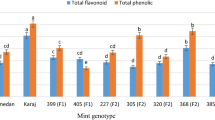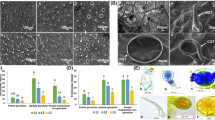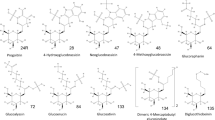Abstract
Mentha arvensis (corn mint) is well known for the production of menthol, a widely used commodity in pharma and flavoring industries and provides natural fragrances and products. Glandular trichomes are specialized hairs found on the aerial surface of vascular plants species producing specific secondary metabolite chemistry. Correlations were established among trichomes, oil yield, and major secondary metabolites. Nine improved, elite cultivars representing different M. arvensis genotypes were used for analysis. Phenotypic coefficient of variation (PCV) and genotypic coefficient of variation (GCV) were estimated; results indicated the presence of considerable amount of genetic variability, thereby emphasizing wide scope of selection. Positive and significant associations were found among glandular trichomes, oil yield, essential oil constituents, and leaf morphology itself, whereas morphological parameters of leaf show positive and negative correlations to average number of trichome and essential oil constituents. Average number of glandular, non-glandular trichomes, their ratios, menthol content, and trichome number showed a good heritability. Trichomes were studied microscopically in leaf parts in all varieties for analyzing their distribution pattern. The trichome number variations showed significant correlation throughout the genotypes with essential oil yield and monoterpenoid constituents. Differential changes were analyzed for Glutathione S-transferases, Glutathione reductase, Malondialdehyde, phenolics, and chlorophyll content. Gene expressions were analyzed for biosynthesis genes and selected transcription factors TRANSPARENT TESTA GLABRA 1 (TTG1), ENOLASE 1, GLABRA 3, GTL 1, NUCLEAR TRANSCRIPTION FACTOR Y SUBUNIT B-6, WRKY transcription factor 22, putative WRKY 33, WRKY 17, WRKY 1, and WRKY 65-like for harnessing their relation with trichome development in M. arvensis genotypes.










Similar content being viewed by others
References
Aditya JP, Bhartiya P, Bhartiya A (2011) Genetic variability, heritability and character association for yield and component characters in soybean (G. max (L.) Merrill). J Cent Eur Agric 12(1):27–34
Aksita H, Demirtas I, Telci I, Tarimcilar G (2013) Chemical diversity in essential oil composition of Mentha longifolia [L] Hudson subsp. typhoides [Briq] Harley var. typhoides from Turkey. J Essent Oil Res 25(5):430–437
Altschul SF, Gish W, Miller W, Myers EW, Lipman DJ (1990) Basic local alignment search tool. J Mol Biol 215(3):403–410
Amelunxen F (1965) Elektronenmikroskopische untersuchungen an den druenschuppen von mentha piperita L. Plant Med 13:457–473
Annicchiarico P, (2002). Genotype Environmental Interactions: Challenges and Opportunities for Plant Breeding and Cultivar Recommendations. FAO Plant Production and Protection Paper. FAO, Rome. pp. 174.
Anonymous (2003) Menthol mint variety ‘Kushal’ released for late transplanting. CIMAP Newsletter 1:3–4
Bosabalidis AM (2002) Structural features of Origanum sp. In: Kintzios SE (ed) Oregano the genera Origanum and Lippia. Taylor and Francis, London, pp 11–64
Burton GW, Vane EH (1953) Estimating heritability in tall fescue (Festuca arundinacea) from replicated clonal materials. Agron J 45:478–481
Croteau RB, Davis EM, Ringer KL, Wildung MR (2005) (−)-Menthol biosynthesis and molecular genetics. Naturwissenschaften 92(12):562–577
Dewey DR, Lu KH (1959) A correlation and path-coefficient analysis of components of crested wheatgrass seed production. Agron J 51:515–518
Estepa RR, Langei LJM, Lange MB (2010) Mathematical modeling-guided evaluation of biochemical, developmental, environmental, and genotypic determinants of essential oil composition and yield in peppermint leaves. Plant Physiol 152:2105–2119
Fahn A (1979) Secretory tissues in plants. Academic, New York, pp 162–16
Fahn A (1988) Secretory tissues in plants. New. Phytol. 108: 229–257.
Failmezger H, Jaegle B, Schrader A, Hulskamp M, Tresch A (2013).Semi-automated 3D Leaf Reconstruction and Analysis of Trichome Patterning from Light Microscopic Images . PLoS Comput Biol 9: e1003029 H, Jaegle B, Schrader A, Hulskamp M, Tresch A (2013).Semi-automated 3D Leaf Reconstruction and Analysis of Trichome Patterning from Light Microscopic Images . PLoS Comput Biol 9: e1003029
Gershenzon J, Maffei M, Croteau R (1989) Biochemical and histochemical localization of mono-terpene biosynthesis in the glandular trichomes of spearmint (Mentha spicata). Plant Physiol 89:1351–1357
Greese B, Hulskamp M, Christian Fleck M (2014) Quantification of variability in trichome patterns, Front Plant Sci. 5: 596
Gershenzon J, Mcconkey M, Croteau R (2000) Regulation of monoterpene accumulation in leaves of peppermint (Mentha piperita L.). Plant Physiol 122:205–213
Glas JJ, Schimmel BCJ, Alba MJ, Bravo ER, Schuurink RC, Kant MR (2012) Plant glandular trichomes as targets for breeding or engineering of resistance to herbivores. Int J Mol Sci 2012
Hauser T, Harr B, Schlotterer C, (2001) Trichome distribution in Arabidopsis thaliana and its close relative Arabidopsis lyrata: molecular analysis of the candidate gene GLABROUS1. Mol Biol Evol 18(9):1754–1763
Huang X, Madan A (1999) CAP3: a DNA sequence assembly program. Genome Res 9(9):868–877
Khanuja SPS, Shasany AK, Srivastava A, Kumar S (2000) Assessment of genetic relationships in Mentha species. Euphytica 111:121–125
Khanuja SPS, Kumar S, Shasany AK, Dhawan S, Darokar MP, Naqvi AA, Dhawan DO, Singh AK, Patra NK, Bahl JR, Bansal RP (2001) A menthol tolerant variety ‘Saksham’ of Mentha arvensis yielding high menthol. J Med Aromat Plant Sci 23:110–112
Kjonaas R, Venkatachalam KV, Croteau R (1985) Metabolism of monoterpenes: oxidation of isopiperitenol to isopiperitenone, and subsequent isomerization to piperitenone, by soluble enzyme preparations from peppermint (Mentha piperita) leaves. Arch Biochem Biophys 238:49–60
Kumar S, Sharma A, Tiwari R, Kumar A (1994) Gomti, a new improved variety of Japanese mint developed. CIMAP Newsletter 21:2–3
Kumar S, Sharma S, Kumar VS (1998) High yielding variety Kosi of menthol mint developed. CIMAP Newsletter 25:2–3
Kumar S, Bahl JR, Bansal RP, Kukreja AK, Garg SN, Naqui R, Luthra AA, Sharma S (2000) Profiles of the essential oils of Indian menthol mint Mentha arvensis cultivars at different stages of crop growth in northern plains. J Med Aromat Plant Sci 22:774–786
Lal RK (2007) Stability and genotypes × environment interactions in fennel. J Herbs Spices Med Plants 13:47–54
Lal RK (2013) Adaptability patterns and stable cultivar selection in menthol mint (Mentha arvensis L.). Ind Crop Prod 50:176–181
Lal RK, Sharma JR, Sharma S (2000) Variability and stability pattern in economic traits of chamomile (Chamomilla recutita). J Med Aromat Plant Sci 22:219–222
Livak KJ, Schmittgen TD (2001) Analysis of relative gene expression data using real-time quantitative PCR and the 2−ΔΔCT method. Methods 25(4):402–408
Lommen WJ, Schenk E, Bouwmeester HJ, Verstappen FW (2006) Trichome dynamics and artemisinin accumulation during development and senescence of Artemisia annua leaves. Planta Med 72(4):336–345
Loomis WD (1978) Physiology of essential oil production in mint. Proc Oregon Essen Oil Growers League 29:23–24
McCaskill D, Croteau R (1995) Monoterpene and sesquiterpene biosynthesis in glandular trichomes of peppermint (Mentha piperita) rely exclusively on plastid-derived isopentenyl diphosphate. Planta 197:49–5
McCaskill D, Gershenzon J, Croteau R (1992) Morphology and monoterpene biosynthetic capabilities of secretory cell clusters isolated from glandular trichomes of peppermint (Mentha piperita L.). Planta 187:445–454
Mclellan T (2005) Correlated evolution of leaf shape and trichomes in Begonia dregei (Begoniaceae). Am J Bot 92(10):1616–1623
Panse VG, Sukhatme PV (1989) Statistical methods for agricultural workers. Indian council of agricultural research. New Delhi, India
Patra NK, Kumar B (2005) Study of genetic variation in open pollinated seed progenies (OPSPs) of the Mentha arvensis cv. Shivalik- J Med Aromat Plant Sci 27:539–543
Porra RJ, Thompson WA, Kriedmann PA (1989) Determination of accurate extinction coefficients and simultaneous equations for assaying chlorophylls a and b extracted with four different solvents: verification of the concentration of chlorophyll standards by atomic absorption spectroscopy. Biochem Biophys Acta 975:384–394
Rawashdeh IAM (2011) Molecular taxonomy among Mentha spicata, Mentha longifolia and Ziziphora tenuior populations using the RAPD technique Jordan. J Biol Sci 4(2):63–67
Reni YP, Rao YK (2013) Genetic variability in soybean [Glycine max (l) Merrill] IJPAES 2013
Sanchita SR, Mishra A, Dhawan SS, Shirke PA, Gupta MM, Sharma A (2015) Physiological performance, secondary metabolite and expression profiling of genes associated with drought tolerance in Withania somnifera. Protoplasma 252:1439–1450
Schnittger A, Folkers U, Schwabb JB, Hulskamp M (1999) Generation of a spacing pattern: the role of TRIPTYCHON in trichome patterning in Arabidopsis. Plant Cell 11(6):1105–1116
Singh AK, Raina VK, Naqvi AA, Pattra NK, Kumar B, Ram P , Khanuja SPS (2005) Essential Oil Composition and Chemoarrays of Menthol Mint (Mentha arvensis L. f. piperascens Malinvaud ex. Holmes) Cultivars. Flav. Fragr. J., 20, 302–305
Turner GW, Gershenzon J, Croteau RB (2000). Distribution of peltate glandular trichomes on developing leaves of peppermint (Mentha x piperita L.). Plant Physiol 124:655–663
Singh RK, Chaudhary BD (1985) Biometrics in quantitative genetics analysis. Kalayani Publishers, New Delhi, pp 39–79
Valarmathi G, Kumar M, Saravanan NA, (2004). Genetic variability and correlation studies for seed related traits in sesame. Sesame and Safflower Newsletter 19:1137-1617
Walker AR, Davison PA, Bolognesi-Winfield AC, James CM, Srinivasan N, Blundell TL, Esch JJ, Marks MD, Gray JC (1999) The transparent testa glabra1 locus, which regulates trichome differentiation and anthocyanin biosynthesis in arabidopsis, encodes a wd40 repeat protein. Plant Cell 11(7):1337–1350
Wellburn AR(1994) Determination of chlorophyll-a and chlorophyll-b, as well as total carotenoids, using various solvents with spectrophotometers of different resolution. J Plant Physiol;144:307–313
Werker E (2000) Trichome diversity and development. Adv Bot Res 31:1–35
Yaseen M, Tajuddin A, Kumar B, Kumar S (2000) Evaluation of menthol min varieties under row spacing in north Indian plains. J Med Aromat Plant Sci 22:205–207
Acknowledgments
The authors express their sincere gratitude to the director of CSIR-CIMAP, India for keen interest and providing facilities for the experiments. Anand Mishra was supported by CSIR—Senior Research Fellowship, India. The authors gratefully acknowledge to USIC, B. B. Ambedkar University, India for providing the SEM facility.
Funding
This work was supported by the Department of Biotechnology, Bio-CARe award project grant BT/AB/08/01/2008(III) GAP 311 and Council of Scientific and Industrial Research, India (CSIR Network Project BSC0110).
Author information
Authors and Affiliations
Corresponding author
Ethics declarations
Competing interests
The authors declare that they have no conflict of interest.
Additional information
Handling Editor: Hanns H. Kassemeyer
Electronic supplementary material
Below is the link to the electronic supplementary material.
ESM 1
(DOCX 14 kb)
Rights and permissions
About this article
Cite this article
Mishra, A., Lal, R.K., Chanotiya, C.S. et al. Genetic elaborations of glandular and non-glandular trichomes in Mentha arvensis genotypes: assessing genotypic and phenotypic correlations along with gene expressions. Protoplasma 254, 1045–1061 (2017). https://doi.org/10.1007/s00709-016-1011-x
Received:
Accepted:
Published:
Issue Date:
DOI: https://doi.org/10.1007/s00709-016-1011-x




